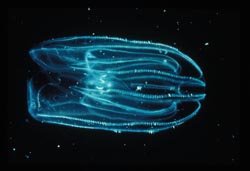Organisms Present in Ballast Water
Ballast water is one of the major vectors for aquatic species invasions. On any given day, it is estimated that more than 5,000 species of freshwater, brackish and marine organisms may be transported in the ballast water of ocean-going vessels around the world.
Many studies have documented the great diversity of organisms present in ballast water. In one study, scientists sampled 159 vessels in Coos Bay, Oregon and found over 360 different types of organisms including copepods (microscopic crustaceans), marine worm larvae, juvenile barnacles, juvenile bivalves, flatworms, diatoms (phytoplankton), snail larvae, and crab larvae (Carlton and Geller 1993). A different study sampled the ballast water of five container ships in Hong Kong and found over 80 different species (Chu et al. 1997).
A separate study sampled vessels traveling from Singapore to Germany and found, amazingly, that one species of copepod was able to thrive and reproduce in the ballast water. In fact, the number of copepods present at the end of the voyage was over 100 times greater than the number present at the beginning of the voyage (Gollasch et al. 2000). Thus under certain conditions, some opportunistic species are able to increase in number while in ballast water, almost like in an incubator.
The organisms found in ballast water are not only plants and animals, but researchers have found species of dinoflagellates (phytoplankton) responsible for creating red tide (also known as harmful algal blooms). Scientists also commonly find many species of bacteria and even the virus known to cause Cholera.
Specific Examples of Species Invasions Attributed to Ballast Water Release
The North American comb jelly Mnemiopsis leidyi was first found in the Black and Azov Seas (between Eastern Europe and Asia) in the 1980s. This species of comb jelly single-handedly decimated the local $250 million dollar-a-year fishing industry in the region (Ruiz et al. 1997). When reproductive, adult comb jellies can release as many as 8000 eggs at a time. This species of comb jelly has no satiation response (it never feels full), so if food is present it will never cease feeding. More information on the North American comb jelly.
The zebra mussel Dreissena polymorpha was first found in the Great Lakes in 1988. This mussel is native to the Caspian Sea region of Asia. Colonies of zebra mussels (as many as 1500 individuals per square meter) may accumulate and clog water-intake pipes and screens of drinking water facilities, industrial facilities, power generating plants, golf course irrigation pipes, cooling systems of boat engines, and boat hulls. Large water users in the Great Lakes region spent over $1 billion to control zebra mussels between 1989-2002. More information on zebra mussels.
The overbight clam Corbula amurensis was first found in the San Francisco Bay/Delta region in 1986. Typical densities of the clam in the northern Bay exceed 2,000 clams per square meter. Corbula amurensis is capable of filtering the entire water column in shallow water almost 13 times per day. At this rate of filtration, there are very few planktonic organisms left in the water column for larger animals to feed upon. This clam also accumulates selenium at roughly three times higher concentrations than the clams that had lived in the northern part of the bay before. The birds and fish that commonly feed on Corbula amurensis are thus ingesting selenium at levels that may lead to reproductive damage, including birth defects, impaired hatching, and reduced growth of young life stages. More information on Corbula amurensis.
Literature Cited:
Carlton, J.T. and J.B. Geller. 1993. Ecological roulette: the global transport of nonindigenous marine organisms. Science, 261: 78-82.
Chu, K.H., Tam, P.F., Fung, C.H. and Q.C. Chen. 1997. A biological survey of ballast water in container ships entering Hong Kong. Hydrobiologica, 352: 201-206.
Gollasch, S., Lenz, J., Dammer, M. and H-G Andres. 2000. Survival of tropical ballast water organisms during a cruise from the INdian Ocean to the North Sea. Journal of Plankton Research, 22(5): 923-937.
Ruiz, G.M., Carlton, J.T., Grosholz, E.D. and A.H. Hines. 1997. Global invasions of marine and estuarine habitats by non-indigenous species: mechansism, exten, and consequences. American Zoologist, 37: 621-632.



